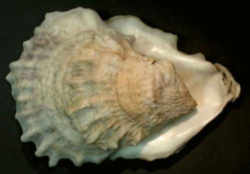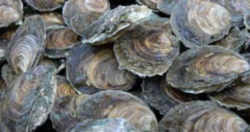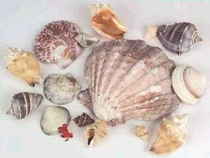
Virginia Symbols
Virginia State Shell
Oyster Shell

(Crassostrea virginica)
Adopted on March 5, 1974.
On March 5, 1974, Virginia adopted the most popular of state shells, the eastern oyster, (Crassostrea virginica,) which also represents Connecticut and Mississippi.
Several Virginia Beach school children carrying oyster shells gathered around Governor Mills E. Godwin Jr. as he signed the oyster into law. One
girl presented Godwin with a shiny oyster shell, and he said, "I come from down in oyster country, you know."
A school group came up with the idea of adopting the oyster which was introduced in the legislature by Owen B.Pickett of Virginia Beach. Pickett thought
an official oyster might help promote tourism.
Virginia's oyster capital is the Menchville area. It is located in southern Virginia on the James River, the largest natural seed oyster bed in the
Chesapeake Bay area. In winter, boats from all over to Virginia coast gather at Menchville to work on the public seed beds. Boats from Maryland and
northern Virginia also visit Menchville to buy seed oysters, which they plant in the upper Chesapeake Bay and in rivers.
Virginia even has an official boat to harvest oysters from, the Chesapeake Bay deadrise!
Virginia State Shell: Oyster Shell

The Eastern oyster is relatively large, growing up to 10 cm. in length. It is normally somewhat pear-shaped in outline, but members of this species vary greatly in size and shape. The shell is dirty gray externally and white internally, except for the muscle scar, which is deep purple. Oysters usually colonize in beds. Competition for space is a most important source of mortality. Uncrowded, oysters can live to be 20 years old. The beds are a permanent social structure unless they are separated physically and forcefully. Otherwise, the oysters will re-congregate if they are capable.
Shell
Oyster shells are made of calcium carbonate (lime). The oysters must get this lime from the water they live in. They also have a sort of skin, called a mantle, which puts this calcium carbonate on the outside of their bodies to form a protective shell. Oysters must live in water that is temperate (warm all year) and not too cloudy. They grow only in areas where salt and fresh water mix together, like salt marshes. Oysters are born as free-swimming plankton (tiny microscopic organisms). When they grow up, they find a place (on mud, coral, debris, or other oyster shells) to attach and grow. Once they grow their shells, they can't move around anymore. When the tide is high, oysters are covered by water, but when the tide goes out, they are left sticking up into the dry air. Their shells close tightly together so the animal inside will not dehydrate (dry out) before the tide comes back in.
Diet
After spawning in early spring, the oyster loses a great deal of weight. This event usually coincides with the spring bloom of phytoplankton, their primary food source. Feeding is dependent upon water temperature; more food is consumed at higher temperatures than at lower. Oysters are filter-feeders. They suck in water and filter out the plankton and detritus to swallow. Then they spit the water back out. (Detritus is dead plant and animal matter.)
Reproduction
Reproductive organs can be readily observed only during the breeding season. There is no reproductive activity during the winter. Sexual maturity is a function of size rather than age. The first spawning usually occurs when the oyster is 2 years of age. Fertilization occurs when huge numbers of sperm sperm and eggs are expelled from the male or female and meet in the water.
Pearls
The oyster's mantle (skin) makes both an outer white crusty shell, and a smooth inner shell. The smooth inner part is called "nacre" or "Mother of Pearl." Sometimes a bit of sand gets inside the oyster's shell. This is very irritating to the oyster, like getting an eyelash in your eye. So the oyster covers this bit of dirt with shiny smooth Mother of Pearl. It keeps covering the dirt and rolling it around until it doesn't cause any more irritation. This makes a pearl. The oysters that people eat in north Florida (Eastern oysters) hardly ever make pretty pearls. But there are other kinds of oysters, clams, mussels, conchs, whelks, and even abalone that do make nice pearls. We think of pearls as being round and white, but they are often yellow or black, and many other colors and shapes.
Virginia Law
The law designating oyster shell as the official Virginia state shell is found in the Code of Virginia, Title 1, Chapter 5, Section 1-510. Virginia symbols were re-organized under one section of the Code of Virginia in 2005.
Title 1 - GENERAL PROVISIONS.
Chapter 5 - Emblems
§ 1-510. Official emblems and designations.
The following are hereby designated official emblems and designations of the Commonwealth:
Artisan Center - "Virginia Artisans Center," located in the City of Waynesboro.
Bat - Virginia Big-eared bat (Corynorhinos townsendii virginianus).
Beverage - Milk.
Blue Ridge Folklore State Center - Blue Ridge Institute located in the village of Ferrum.
Boat - "Chesapeake Bay Deadrise."
Covered Bridge Capital of the Commonwealth - Patrick County.
Covered Bridge Festival - Virginia Covered Bridge Festival held in Patrick County.
Dog - American Foxhound.
Emergency medical services museum - "To The Rescue," located in the City of Roanoke.
Fish - Brook Trout.
Fleet - Replicas of the three ships, Susan Constant, Godspeed, and Discovery, which comprised the Commonwealth's founding fleet that brought
the first permanent English settlers to Jamestown in 1607, and which are exhibited at the Jamestown Settlement in Williamsburg.
Flower - American Dogwood ( Cornus florida).
Folk dance - Square dancing, the American folk dance that traces its ancestry to the English Country Dance and the French Ballroom Dance, and is called,
cued, or prompted to the dancers, and includes squares, rounds, clogging, contra, line, the Virginia Reel, and heritage dances.
Fossil - Chesapecten jeffersonius.
Gold mining interpretive center - Monroe Park, located in the County of Fauquier.
Insect - Tiger Swallowtail Butterfly (Papilio glaucus Linne).
Motor sports museum - "Wood Brothers Racing Museum and Virginia Motor Sports Hall of Fame," located in Patrick County.
Outdoor drama - "The Trail of the Lonesome Pine Outdoor Drama," adapted for the stage by Clara Lou Kelly and performed in the Town of Big
Stone Gap.
Outdoor drama, historical - "The Long Way Home" based on the life of Mary Draper Ingles, adapted for the stage by Earl Hobson Smith, and
performed in the City of Radford.
Shell - Oyster shell (Crassostrea virginica).
Song emeritus - "Carry Me Back to Old Virginia," by James A. Bland, as set out in the House Joint Resolution 10, adopted by the General Assembly
of Virginia at the Session of 1940.
Sports hall of fame - "Virginia Sports Hall of Fame," located in the City of Portsmouth.
War memorial museum - "Virginia War Museum," (formerly known as the War Memorial Museum of Virginia), located in the City of Newport News.
(Code 1950, § 7-35, 7-36, 7-37; 1966, cc. 102, 547, § 7.1-37, 7.1-38, 7.1-39; 1974, c. 24, § 7.1-40; 1982, c. 191, § 7.1-40.1;
1986, c. 138, § 7.1-40.2; 1988, c. 317, § 7.1-40.3; 1991, cc. 71, 575, § 7.1-40.4, 7.1-40.5; 1993, cc. 251, 509, § 7.1-40.6; 1994,
cc. 33, 134, 220, 464, § 7.1-40.2:1, 7.1-40.8; 1995, cc. 12, 180, § 7.1-40.2:2; 1996, c. 52, § 7.1-40.9; 1997, cc. 66, 576, § 7.1-40.10;
1999, cc. 69, 336, § 7.1-40.11; 2001, cc. 97, 134, § 7.1-40.12; 2001, c. 228, § 7.1-40.13; 2005, cc. 557, 839; 2006, c. 128; 2007, cc.
391, 685; 2008, c. 262.)
Taxonomic Hierarchy: Oyster
Kingdom: Animalia
Phylum: Mollusca
Class: Bivalvia
Order: Ostreoida
Family: Ostreidae
Genus: Crassostrea
Species: Crassostrea virginica







